This comprehensive guide outlines steps for safely disposing of old or damaged electrical devices, including identifying the type of device, checking with the manufacturer, contacting local authorities and recycling centers, donating or selling still-functional devices, properly packaging and transporting devices, considering environmental impacts, and avoiding harmful disposal methods.

How to Safely Dispose of Old or Damaged Electrical Devices
Electrical devices, when no longer functional or outdated, should be disposed of properly to prevent environmental harm and ensure the safety of individuals. Here's a comprehensive guide on how to do so:
Identify the Type of Device
Firstly, identify the type of device you want to dispose of. This can range from small appliances like toasters and hair dryers to larger items such as televisions and refrigerators. Each type may have different disposal requirements.
Check with the Manufacturer
Some manufacturers offer take-back programs for their products. Check if your device's manufacturer provides such services. They might even offer discounts on new purchases if you recycle the old one through them.
Local Authorities and Recycling Centers
Contact Your Local Council or Municipality
Many local governments provide guidelines or services for disposing of electronic waste. They may have designated days for bulky waste collection or specific centers where you can bring your electrical devices.
Visit Recycling Centers
Find recycling centers in your area that accept electronic waste. These centers are equipped to handle the disposal of electrical devices safely. Some may charge a fee, while others are free.
Donating or Selling
If your device is still functional but you no longer need it, consider donating it to charities or selling it online. This extends its lifespan and reduces waste.
Properly Packaging the Device
Before transporting the device:
- Unplug and uninstall it safely.
- Remove any batteries if possible.
- Clean the device to remove any residual chemicals or dust.
- Place the device in a box with proper padding to avoid damage during transport.
Transportation
Transport the device carefully to its destination, whether it's a recycling center, donation shop, or your local council's waste facility. Use a vehicle that can safely accommodate the size and weight of the device.
Environmental Considerations
Hazardous Materials
Be aware that some devices contain hazardous materials like mercury or lead, which require special handling to prevent environmental contamination.
Energy Efficiency
When buying a replacement device, consider energy-efficient models to reduce your environmental impact over time.
What to Avoid
- Do not dispose of electronics in regular trash bins.
- Avoid illegal dumping sites; these can harm the environment severely.
- Never incinerate electronic devices as this can release toxic chemicals.
By following these steps, you can ensure that your old or damaged electrical devices are disposed of responsibly, contributing to a safer and healthier environment for everyone.